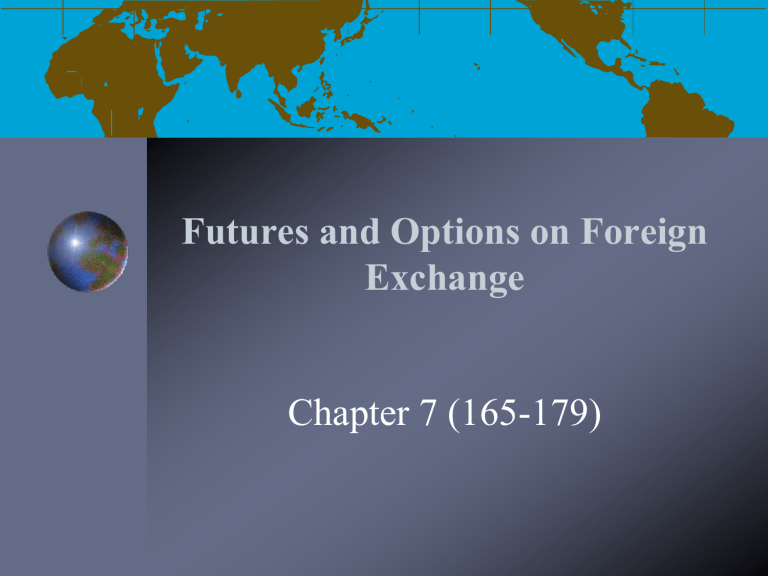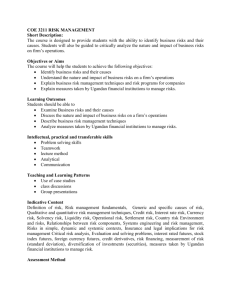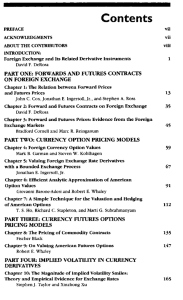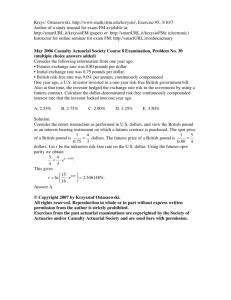Futures Contracts: Preliminaries

Futures and Options on Foreign
Exchange
Chapter 7 (165-179)
Lecture Objectives
Futures Contracts: Preliminaries
Currency Futures Markets
Basic Currency Futures Relationships
Options Contracts: Preliminaries
Currency Options Markets
Currency Futures Options
Basic Option Pricing Relationships at Expiry
Global Futures and Options Volume
Source: Futures Industry Association
Top 7 Derivative Exchanges
Source: Futures Industry Association
Top 5 Most Actively Traded
Contracts Worldwide
Source: Futures Industry Association
Survey of Derivative Usage
From the Wharton School derivative survey
Survey of 350 US firms (ended 1998)
Firms were selected randomly, grouped by size into large capitalization (capitalization greater than 250 million), medium capitalization
(between 50 and 250 million), and small (less than 50 million)
Percentage of Firms that Use Derivatives
Services
Manufacturing
Primary Product
Small
Medium
Large
0% 10% 20% 30% 40% 50% 60% 70%
Reasons for Preferring Forwards
Frequency Reasons to Prefer Forwards to
Options
Forwards are better suited to expenses
Currency options are excessively expensive
Firm lacks knowledge required to use currency options
63%
35%
8%
Futures Contracts: Preliminaries
A futures contract is like a forward contract:
It specifies that a certain currency will be exchanged for another at a specified time in the future at prices specified today.
A futures contract is different from a forward contract:
Futures are standardized contracts trading on organized exchanges with daily resettlement through a clearinghouse.
http://www.pbs.org/itvs/openoutcry/thepit.html
http://www.youtube.com/watch?v=VwfCwG1-y60&NR=1
Futures Contracts: Preliminaries
Standardizing Features:
Contract Size
Delivery Month
Daily resettlement
Initial performance bond (about 2% of contract value, cash or T-bills held in a street name at your brokerage).
Daily Resettlement: An Example
Consider a long position in the CME Euro/U.S.
Dollar contract.
It is written on €125,000 and quoted in $ per €.
The strike price is $1.30; the maturity is 3 months.
At initiation of the contract, the long posts an initial performance bond of $6,500.
The maintenance performance bond is $4,000.
Daily Resettlement: An Example
Recall that an investor with a long position gains from increases in the price of the underlying asset.
Our investor has agreed to BUY €125,000 at $1.30 per euro in three months.
With a forward contract, at the end of three months, if the euro was worth $1.24, he would lose $7,500
= ($1.24 – $1.30) × 125,000.
If instead at maturity the euro was worth $1.35, the counterparty to his forward contract would pay him $6,250 = ($1.35 – $1.30) × 125,000.
Daily Resettlement: An Example
With futures, we have daily resettlement of gains and losses rather than one big settlement at maturity.
Every trading day: if the price goes down, the long pays the short if the price goes up, the short pays the long
Performance Bond Money
Each day’s losses are subtracted from the investor’s account.
Each day’s gains are added to the account.
In this example, at initiation the long posts an initial performance bond of $6,500.
The maintenance level is $4,000.
If this investor loses more than $2,500 he has a decision to make: he can maintain his long position only by adding more funds—if he fails to do so, his position will be closed out with an offsetting short position.
Daily Resettlement: An Example
Over the first 3 days, the euro strengthens, and then depreciates in dollar terms:
Settle Gain/Loss Account Balance
$1.31
$1.30
$1.27
$1,250*
–$1,250
–$3,750
$7,750 = $6,500 + $1,250
$6,500
$2,750 {+ $3,750 = $6,500}
On third day suppose our investor keeps his long position open by posting an additional $3,750.
Note: * =($1.31-$1.30)x 125,000
Daily Resettlement: An Example
Over the next 2 days, the long keeps losing money and closes out his position at the end of day five.
Settle
$1.31
$1.30
$1.27
$1.26
$1.24
Gain/Loss
$1,250
–$1,250
–$3,750
–$1,250
–$2,500
Account Balance
$7,750
$6,500
$2,750 + $3,750 = $6,500
$5,250 = $6,500 – $1,250
$2,750
Daily Resettlement: An Example
At the end of his adventures, our investor has three ways of computing his gains and losses:
Sum of daily gains and losses
– $7,500 = $1,250 – $1,250 – $3,750 – $1,250
– $2,500
Contract size times the difference between initial contract price and last settlement price.
– $7,500 = ($1.24/€ – $1.30/€) × €125,000
Ending balance on account minus beginning balance on account, adjusted for deposits or withdrawals.
– $7,500 = $2,750 – ($6,500 + $3,750)
Daily Resettlement: An Example
Settle
$1.30
$1.31
$1.30
$1.27
$1.26
$1.24
Gain/Loss
–$–
$1,250
–$1,250
–$3,750
–$1,250
–$2,500
Total loss = – $7,500
Account Balance
$6,500
$7,750
$6,500
$2,750
$5,250
+ $3,750
$2,750
= ($1.24 – $1.30) × 125,000
= $2,750 – ($6,500 + $3,750)
Currency Futures Markets
The Chicago Mercantile Exchange (CME) is by far the largest.
Others include:
The Philadelphia Board of Trade (PBOT)
The Tokyo International Financial Futures Exchange
The London International Financial Futures Exchange
Singapore International Monetary Exchange (SIMEX)
The Chicago Mercantile Exchange
Expiry cycle: March, June, September, December.
Delivery date 3rd Wednesday of delivery month.
Last trading day is the second business day preceding the delivery day.
CME hours 7:20 a.m. to 2:00 p.m. CST.
Extended-hours trading on GLOBEX runs from 2:30 p.m. to 4:00 p.m. dinner break and then back at it from 6:00 p.m. to 6:00 a.m. CST.
Basic Currency
Futures Relationships
Open Interest refers to the number of contracts outstanding for a particular delivery month.
Open interest is a good proxy for demand for a contract.
Some refer to open interest as the depth of the market. The breadth of the market would be how many different contracts (expiry month, currency) are outstanding.
Reading Currency Futures Quotes
OPEN HIGH LOW SETTLE CHG
Euro/US Dollar (CME)—€125,000; $ per €
Mar
Jun
1.4748
1.4830
1.4700
1.4737
1.4818
1.4693
1.4777
.0028
1.4763
.0025
OPEN
INT
172,396
2,266
Expiry month
Opening price
Highest price that day
Closing price
Daily Change
Lowest price that day
Number of open contracts
Reading Currency Futures Quotes
OPEN HIGH LOW SETTLE CHG
Euro/US Dollar (CME)—€125,000; $ per €
Mar
Jun
1.4748
1.4830
1.4700
1.4737
1.4818
1.4693
1.4777
.0028
1.4763
.0025
OPEN
INT
172,396
2,266
Notice that open interest is greatest in the nearby contract, in this case March, 2008.
In general, open interest typically decreases with term to maturity of most futures contracts.
Basic Currency Futures Relationships
OPEN HIGH LOW SETTLE CHG
OPEN
INT
Euro/US Dollar (CME)—€125,000; $ per €
Mar
Jun
1.4748
1.4830
1.4700
1.4737
1.4818
1.4693
1.4777
.0028
1.4763
.0025
172,396
2,266
The holder of a long position is committing himself to pay
$1.4777 per euro for €125,000—a $184,712.50 position.
As there are 172,396 such contracts outstanding, this represents a notational principal of over $31.8 billion!
Options Contracts: Preliminaries
An option gives the holder the right, but not the obligation , to buy or sell a given quantity of an asset in the future, at prices agreed upon today.
Calls vs. Puts
Call options gives the holder the right, but not the obligation, to buy a given quantity of some asset at some time in the future, at prices agreed upon today.
Put options gives the holder the right, but not the obligation, to sell a given quantity of some asset at some time in the future, at prices agreed upon today.
Options Contracts: Preliminaries
European vs. American options
European options can only be exercised on the expiration date.
American options can be exercised at any time up to and including the expiration date.
Since this option to exercise early generally has value, American options are usually worth more than European options, other things equal.
Options Contracts: Preliminaries
In-the-money
The exercise price is less than the spot price of the underlying asset.
At-the-money
The exercise price is equal to the spot price of the underlying asset.
Out-of-the-money
The exercise price is more than the spot price of the underlying asset.
Option Contracts: Preliminaries
Intrinsic Value
The difference between the exercise price of the option and the spot price of the underlying asset.
Speculative Value
The difference between the option premium and the intrinsic value of the option.
Option
Premium
=
Intrinsic
Value
+
Speculative
Value
Currency Options Markets
PHLX
HKFE
20-hour trading day.
OTC volume is much bigger than exchange volume.
Trading is in six major currencies against the
U.S. dollar.
PHLX Currency Option Specifications
Currency
Australian dollar
British pound
Canadian dollar
Euro
Japanese yen
Swiss franc
Contract Size
AD50,000
£31,250
CD50,000
€62,500
¥6,250,000
SF62,500
Basic Option Pricing
Relationships at Expiry
At expiry, an American call option is worth the same as a European option with the same characteristics.
If the call is in-the-money, it is worth S
T
– E
.
If the call is out-of-the-money, it is worthless.
C aT
= C eT
= Max [ S
T
- E , 0]
Basic Option Pricing
Relationships at Expiry
At expiry, an American put option is worth the same as a European option with the same characteristics.
If the put is in-the-money, it is worth E - S
T
.
If the put is out-of-the-money, it is worthless.
P aT
= P eT
= Max [ E - S
T
, 0]
Basic Option Profit Profiles
Profit
If the call is inthe-money, it is worth S
T
– E
.
Owner of the call
If the call is outof-the-money, it is worthless and the buyer of the call
– c
0 loses his entire investment of c
0
.
Out-of-the-money
E
E + c
0
In-the-money loss
Long 1 call
S
T
Basic Option Profit Profiles
Profit
Seller of the call If the call is in-themoney, the writer loses S
T
– E
.
If the call is out-ofthe-money, the writer keeps the option premium.
c
0
E
E + c
0 loss
Out-of-the-money
S
T
In-the-money short 1 call
Basic Option Profit Profiles
Profit
If the put is inthe-money, it is worth E – S
T
.
The maximum gain is E
– p
0
E
– p
0
Owner of the put
If the put is outof-the-money, it is worthless and the buyer of the put loses his entire investment of p
0
.
– p
0 loss
E
– p
0
In-the-money
E
S
T long 1 put
Out-of-the-money
Basic Option Profit Profiles
Profit
If the put is in-themoney, the writer loses E – S
T
. The maximum loss is –
E + p
0
Seller of the put
If the put is out-ofthe-money, it is worthless and the seller of the put keeps the option premium of p
0
.
p
0
–
E + p loss
0
E
– p
0
E
S
T short 1 put
Profit
Consider a call option on £31,250.
The option premium is
$0.25 per pound
The exercise price is
$1.50 per pound.
–$0.25
Example
$1.75
$1.50
loss
Long 1 call on 1 pound
S
T
Profit
Consider a call option on £31,250.
The option premium is
$0.25 per pound
The exercise price is
$1.50 per pound.
–$7,812.50
Example
$1.75
$1.50
loss
Long 1 call on £31,250
S
T
Profit
Example
What is the maximum gain on this put option?
$42,187.50
$42,187.50 = £31,250×($1.50 – $0.15)/£
At what exchange rate do you break even?
Consider a put option on £31,250.
The option premium is
$0.15 per pound
–$4,687.50
The exercise price is
$1.50 per pound.
loss
$1.35
$1.50
S
T
Long 1 put on £31,250
$4,687.50 = £31,250×($0.15)/£
Market Value, Time Value and Intrinsic
Value for an American Call
Profit
The red line shows the payoff at maturity, not profit, of a call option.
Long 1 call
Note that even an out-of-the-money option has value— time value.
Intrinsic value
S
T
Time value
Out-of-the-money In-the-money loss E
Example
For a call on Euro with strike price k = US¢/€ 91.5.
The intrinsic value is 5¢ if the spot rate is 96.5¢.
Time value is 1¢ if the market price is 6¢.
The intrinsic value is 0 if the spot rate is 88¢ (or any other price equal to or below 91.5¢). Time value is 2¢ if market price is 2.
For put with strike price k = US¢/€ 91.5.
The intrinsic value is 0 if the spot rate is 96.5¢.
Time value is 2 if the market price is 2¢.
The intrinsic value is 3.5¢ if the spot rate is 88¢. Time value is 1.5¢ if market price is 5.
Learning outcomes
• Discuss the similarities and differences between forward and futures.
• Explain the difference between hedgers and speculators
• Explain why most futures positions are closed out through a reversing trade rather than held to delivery
• Define the call and put options; the rights of the buyers and obligations of the sellers
• Explain the differences between European and American options
• Know the basic option pricing relationships at expiration
• Basic option profit profiles (all four of them)
• Know how to calculate the intrinsic value and time value of the options
• Know how to calculate the profit/loss of long/short call and put speculative positions
(for example, see the numerical examples done in class)





